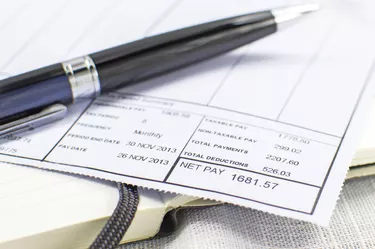
Although some payroll deductions like IRS withholding may be refunded when you file your income tax return, there are others that don't come back to you. This is because the U.S. federal government uses some deductions to fund federal programs. The code Fed OASDI/EE on a paycheck indicates one of these nonrefundable deductions. It represents your contribution to the Social Security system.
Consider Also: How to Calculate Social Security Tax
Video of the Day
Video of the Day
What Does OASDI/EE Stand For?
The acronym Fed OASDI EE stands for Federal Old Age Survivors and Disability Insurance Employee Expense, which refers to a tax for Social Security. All workers are required to contribute to Social Security by paying this tax in order to be eligible for benefits when the time comes. Employers are required to make a matching contribution that cannot be deducted from the employee's pay. People who are self-employed are responsible for paying both the employee and employer portions of this tax.
Consider Also: Independent Contractor Tax Deductions
What Do OASDI/EE Taxes Cover?
The taxes collected under OASDI/EE pay for Social Security benefits, such as those paid to retirees aged 62 and older and in some cases their families. It also covers disability benefits for people who have been unable to work for at least 12 months due to medical or physical impairment. Social Security also pays survivor benefits to widowed spouses and the children of deceased workers.
Consider Also: Do You Pay Taxes on Disability Payments?
The Social Security tax rate determines the amount withheld for OASDI/EE. For 2021, the rate is 6.2 percent for both the employee and employer and 12.4 percent for self-employed workers. For a worker making $100,000, annual OASDI withholding should be $6,200; the worker's employer should also contribute $6,200. A self-employed worker with the same income would be required to pay $12,400.
The federal government defines a ceiling on how much income is required for Social Security taxation. For 2021, the taxable maximum income for OASDI/EE deductions is set at $142,800. This means that employees who have higher annual earnings are only required to pay Social Security taxes on $142,800 of their income.
This maximum limit is referred to by Social Security as the contribution and benefit base. It's also used to calculate benefits for workers with higher incomes.
Who's Exempt From OASDI/EE?
Although the vast majority of workers are required to pay OASDI/EE, the federal government does provide some exemptions. People who receive these exemptions must be part of a specific group, such as employees of foreign governments and members of certain religious sects that are officially opposed to Social Security benefits. An exemption saves workers money but they will not be able to collect Social Security benefits at some point in the future.
In some cases, an employee's Social Security tax exemption is automatic because the employer does not withhold for OASDI/EE. In other cases, tax exemption is not automatic and must be applied for with IRS Form 4029: Application for Exemption from Social Security and Medicare Taxes and Waiver of Benefits.
Exempt workers who experience a life change that causes them to lose their exempt status are required to notify the IRS within 60 days. Instructions are provided on Form 4029.
Qualifying for an OASDI/EE Refund
Although money deducted for OASDI/EE taxes is typically not refunded, there are cases where workers who have more than one job may overpay. For example, if your total salary from two different jobs in 2021 is more than the maximum taxable limit of $142,800, then your employers might have withheld too much in total.
In this case, there is a section of IRS Form 1040 where you can apply for a refund of the amount overpaid. If you have a single employer who withholds too much, you should seek a refund from the employer.
Social Security Tax Rate